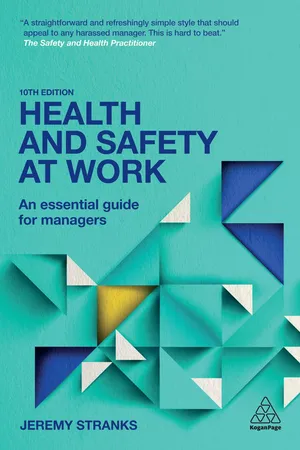
Health and Safety at Work
An Essential Guide for Managers
Jeremy Stranks
- English
- ePUB (mobile friendly)
- Available on iOS & Android
Health and Safety at Work
An Essential Guide for Managers
Jeremy Stranks
About This Book
This practical guide for employers in the UK continues to provide managers with the essential advice on how to establish health and safety procedures in organizations. Written in jargon-free language, Health and Safety at Work cuts through the legal complexities to enable you to fully understand the law and its implications for your business. Filled with expert knowledge and written in an accessible style, this book equips you with the legal and practical knowledge you need to protect your employees and your business. This 10th Edition of the indispensable guide, Health and Safety at Work, has been updated to comply with all recent changes and additions to Health and Safety law including The Reporting of Injuries, Diseases and Dangerous Occurrences Regulations 2013, The Construction (Design and Management) Regulations 2015 and increased legislation and prioritisation of issues of stress at work. This new edition also comes with downloadable online resources and templates that you can use in your business.
Frequently asked questions
Information
Part 1
Health and Safety Management and Administration
1
Principal Legal Requirements
CRIMINAL AND CIVIL LIABILITY
1. Criminal liability
2. Civil liability
HEALTH AND SAFETY AT WORK ACT (HASAWA) 1974
1. Duties of employers
- the provision and maintenance of plant and systems of work that are safe and without risks to health (HASAWA Section 2(2) (a));
- arrangements for ensuring the safety and absence of health risks in connection with the use, handling, storage and transport of articles and substances (HASAWA Section 2(2) (b));
- the provision of such information, instruction, training and supervision as is necessary to ensure the health and safety at work of employees (HASAWA Section 2(2) (c));
- the maintenance of any place of work under the employer’s control in a condition that is safe and without risks to health, and the provision and maintenance of means of access and egress from it that are safe and without risks to health (HASAWA Section 2(2) (d)); and
- the provision and maintenance of a working environment for his employees that is safe, without risks to health and adequate as regards facilities and arrangements for their welfare at work (HASAWA Section 2(2) (e)).
2. Duties of employees
- to take reasonable care for the health and safety of himself and of other persons who may be affected by his acts or omissions at work; and
- as regards any duty or requirement imposed on his employer or any other person by or under any of the relevant statutory provisions, to co-operate with him so far as is necessary to enable that duty or requirement to be performed or complied with (HASAWA Section 7).
3. Duties of employers to persons other than their employees
4. Duties of occupiers of premises to persons other than their employees
- are not their employees, but
- use non-domestic premises made available to them as a place of work or as a place where they may use plant or substances provided for their use there,